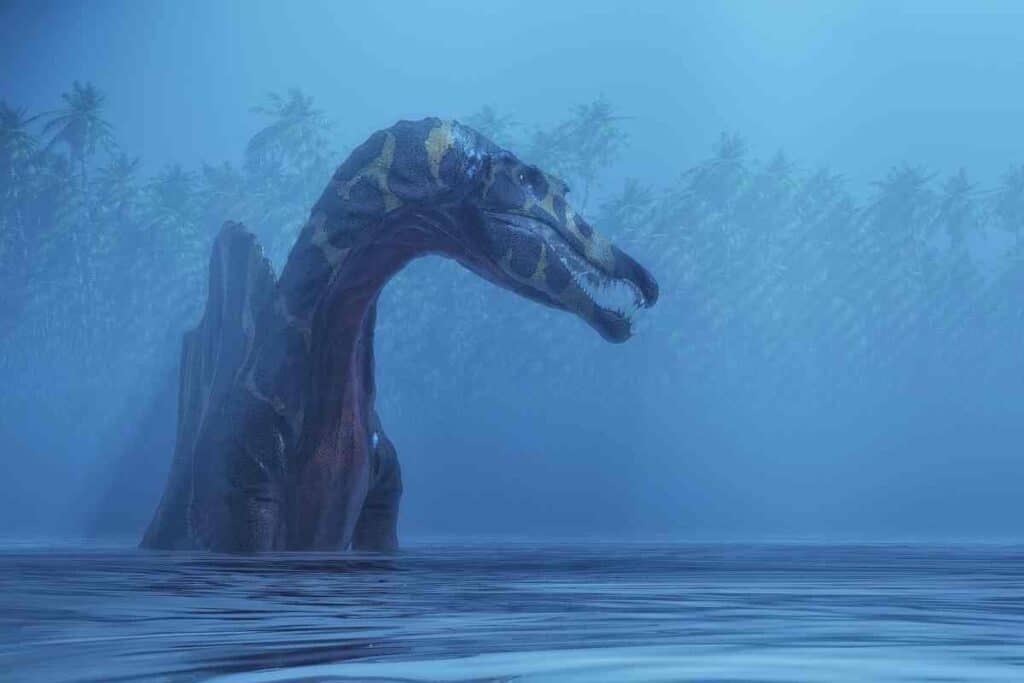Was Spinosaurus A Water Dinosaur? Spinosaurus is one of the most unique dinosaurs found, which lived in the late Cretaceous period and many fossils have been found in Morrocco. A constant subject of debate is its possible lifestyle and habitat. With its features based on limited evidence, scientists have always wondered what habitats Spinosaurus could colonize. This general idea made researchers even more interested and asked – is Spinosaurus aquatic?

Was Spinosaurus A Water Dinosaur?
Research evidence shows that Spinosaurus is the first dinosaur that exhibited aquatic life, living on land and water. It possessed a fin-like tail efficient for water propulsion with a snout structure and teeth specialized for a fish diet.
Spinosaurus is called a “spine lizard” because of its lizard-like features with its great spines positioned dorsally. Evidence and research findings in the past and recent years have found new information on the ecology of this Spinosaurus. This article will summarize characteristics and abilities that might have allowed Spinosaurus to live in water. We will also discuss the recent evidence of these claims that Spinosaurus would have been most comfortable in aquatic habitats.
Table of Contents
Was The Spinosaurus Semi-Aquatic?
Spinosaurus looking like modern crocodiles with an elongated snout and sail on its back have scientists wondering if it also lived a semi-aquatic life. It challenged them to look for evidence to possibly prove that Spinosaurus lived a double (land-water) life. Here are some of those.
A Striking Resemblance: Spinosaurus and Crocodiles Traits
Physical traits in the Spinosaurus can be a resemblance to existing traits in a modern organism. One of these is its duck-looking snout. But out of these, nothing will beat its close resemblance with a crocodile.
Crocodiles are semi-aquatic, wherein they spend their day basking on land and cooling off in the water. It might be interesting that this could also be the case in the Spinosaurus. Its skull is long and narrow like a crocodile with a snout studded with straight to conical teeth. Both are carnivorous, but Spinosaurus shows a snout that could specialize for a fish-eating diet or piscivory if it stayed in the water.
Its skull is the longest among all carnivorous dinosaurs, with nostrils near the eyes, which would allow it to breathe as it peeks up the water’s surface. However, unlike crocodilian, its legs and arms are relatively shorter for its body, implying these might not be the significant organs for mobility.
Spinosaurus tail looks like a hybrid for eel and crocodiles, and it could be a good adaptation for balance and as a propeller in the water. Its mouth anatomy had a biting force that can outperform all existing crocodile taxa but weaker than a T-rex jaw. This jaw power was not mainly considered with bone-crushing ability but could hold a fish trying to escape its mouth. (Source)
Its diet was mainly meat, just like modern-day crocodiles. The majestic back sail of the Spinosaurus is a unique trait that could function for heat regulation, intimidate potential predators, and be a male-attracting device.
A Body Fit For Semi-Aquatic Life: Traits and Abilities Based On Fossils
To survive in a particular environment, be it terrestrial or aquatic, an organism will require specialized traits for adaptation, and for so long, scientists believe that they have already found the key to conclude that Spinosaurus indeed lived in both water and land.
In an expedition by a group of researchers from National Geographic, they have found out that Spinosaurus possesses swimming traits from a fossil found in Morocco just this 2020. Specifically, a fin-like tale capable of tail-propelled locomotion observed in modern aquatic reptiles and fishes.
Its leg bones exhibit high bone density, which allows efficient buoyancy control when in water. The “tail” bones that were discovered looked like a giant paddle required to support the spinosaurus entire body. At the same time, the presence of appendages like arms and legs that can support mobility inland shows that it may also have hunted terrestrial prey. (Source)
The semi-aquatic lifestyle of Spinosaurus is unique among other known dinosaurs.
How Fast Can A Spinosaurus Swim?
A fast-swimming ability is much-needed if you stay and hunt mainly in the water to outcompete other hunters. A specialized tail is the most crucial advantage the Spinosaurus can have that scientists are ecstatic about.
A Misconception of the Spinosaurus Tail
For quite some time, scientists wanted to know the power of the spinosaurus tail. Compared to other dinosaurs, the lifestyle of Spinosaurus was less studied because only a few fossils and just fragments of bones were found. At first, they also thought that dinosaurs did not invade river systems in the earlier periods and just stuck to life on land.
A spinosaurus tail was assumed to be similar to other theropod dinosaurs that were slender and thin in a reconstruction. A therapod’s tail was generally divided into two regions with a robust base and a sleek bird-like tail end for counterbalance and aerodynamic gliding, linking dinosaurs to modern birds. This reconstruction of a spinosaurus remained closer to reality for a period.
Debate-Ender: Proof of Its Tail For Aquatic Lifestyle
In 2020, a new Spinosaurus fossil discovered in Morocco made scientists ecstatic. It was the most significant breakthrough and the debate-ender for the lifestyle of a spinosaurus. The tail bone they dug up was considered to be the most bizarre tail in history after the first Spinosaurus fossil was destroyed during World War II. Scientists were sure that Spinosaurus’ tail bone is nothing of what they have previously imagined.
The extended spines in the tail bones of the Spinosaurus showed flat, extended bones which could reach 53 cm in length. It made them realize that it is like a giant fin that would make the Spinosaurus an adept swimmer. It functions best for propelling the organism in the water.
Through a shape reconstruction and experiment, the spinosaurus tail showed that its tail is more powerful than other dinosaurs in water, comparable to crocodile and newt’s tail, modern reptiles with good thrust and efficiency in moving through waters. It means that it is a tremendous advantage if hunting for prey in aquatic habitats.
This recent finding became concrete evidence of a semi-aquatic habitat exhibited by Spinosaurus. Still, many mysteries are to be solved if it swam in deeper or shallower water which we will surely wait for the following years to come. (Source)
————————————————————————————————
Related Spinosaurus Articles You Might Also Be Interested In:
What Dinosaurs Ate Fish? The Surprising Fish Hunting Dinosaurs
The Most Terrifying Dinosaurs – A List of 13 (with Scenarios!)
What’s the Value of a Real Dinosaur Tooth (Single, On Jawbone)?
————————————————————————————————
Water Habitat: Other Animals Found With Spinosaurus in Kem Kem Beds in Morocco
Now scientists have found out that Spinosaurus lived an aquatic life based on fossils found in Morocco. Other dinosaurs and other marine reptiles were also recorded to be a part of the Kem Kem Bed Assemblage, where the Spinosaurus fossil was found.
Habitats that Favored Spinosaurus
After a series of discoveries, scientists believe that Spinosaurus could live in humid environments such as swamps, mangrove forests, and tidal flats alongside other dinosaurs. With its snout able to feed on fish, highly dense bones, and powerful tails, it could have been a great aquatic predator with pretty much fewer dinosaur competitors.
It was the largest carnivore that required enough area to move around both in water and land. It may also have lived alongside other carnivorous dinosaurs recorded competing for mostly prey on the ground. In addition, only a few fossils were found by paleontologists for study, and most were found in areas that were adjacent or once were a watery plain.
The Kem Kem Beds Assemblage
The Kem Kem Beds in Morocco was a place where a significant amount of dinosaur fossils were found. It is also where other large-bodied meat-eater therapods like Spinosaurus and Carcharodontosaurus were documented.
The discovery of these dinosaurs in one area implies that they may have lived alongside each other when the catastrophic event that ended their existence happened. Among these dinosaurs were a sauropod (Rebbachisaurus garasbae) and another therapod like Deltadromeus agilis.
Other non-avian theropods and pterosaurs and ancient fish, crocodilians, and other reptiles were also recorded in the Kem Kem beds. It dubbed Kem Kem beds as a haven for both dinosaur and non-dinosaur predators.
Conclusion
The pieces of evidence recently discovered by scientists debunk the long-time information that dinosaurs could only colonize the land. Spinosaurus indeed have shown characteristics adapted for aquatic life that make it the first-ever confirmed dinosaur to exhibit this habit. There are arguably many potential pieces of evidence are still lying out there that will answer more of our queries with the mysteries of a Spinosaurus.
Recommended Reading:
● I’ve written a whole article about the most terrifying dinosaurs – see where the Spinosaurus ranks with its special abilities that it could chase prey on land, knock down trees, and swim fast in deep waters
● If you are interested in what dinosaurs ate fish, I’ve written an article which explains why adaptations such as a narrow snout and rows of sharp teeth make these dinosaurs fish-eaters. Naturally, the Spinosaurus is included!
